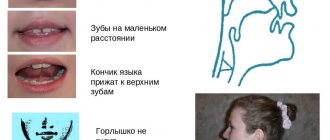At the age of 5-6 years, the child’s pronunciation practically reaches its language norm. At the same time, in some children, age-related speech imperfections turn into a permanent defect due to a number of individual or even pathological features in development.
A problem with the sound R in a child with a full-fledged speech apparatus and hearing is a common disorder, and is called rhotacism in speech therapy. This is one of the types of dyslalia, which, in turn, is further divided into functional and mechanical, with a difference in the root cause of difficulties with sound.
Reasons for the absence of "P"
Speech breathing problems
The direct relationship between breathing and correct speech is very close. If there are no problems, the child inhales through the nose. But for a number of reasons, breathing can become oral or mixed, which leads to deformation of the nasal structure, weakness of the orbicularis oris muscle, and unnatural displacement or drooping of the tongue. Most often, variants of this problem manifest themselves as follows:
- exhalation is intermittent, short, with gradual acceleration;
- breathing is arrhythmic and shallow;
- when inhaling and exhaling, the child twitches his shoulders or head, strongly strains his facial and neck muscles;
- breathing occurs with a delay or additional breaths;
- the child speaks both while exhaling and while inhaling;
- the breathing rhythm is easily lost during emotional or physical stress;
- the air stream is very weak, passes between the edge of the tongue and the cheek, thus creating a squelching sound.
Malocclusion
Anomalies in the relationship between the upper and lower dentition have many causes: from heredity and bad childhood habits to underdevelopment of the jaw muscles and intrauterine pathologies in the mother. The main types of pathological occlusion, due to which sound pronunciation suffers, are:
- prognathic – the upper jaw is strongly shifted forward;
- progenic – the lower jaw moves forward excessively;
- cross – teeth of different sizes, shapes and are displaced in the horizontal plane, the upper or lower jaw is excessively shifted to the left or right;
- open - even with closed teeth, a gap remains between the upper and lower rows.
It is not too late to start correcting your bite at any age, but do not forget that the later the correction begins, the more difficult and lengthy it will be.
Speech hearing impairments
Speech hearing refers to the following natural abilities of a child:
- a sense of the tempo of speech and the ability to reproduce it (rhythmic);
- the ability to accurately recognize and distinguish speech phonemes (phonemic);
- perception of speech melody (sound pitch);
- perception of sounds that differ in sound, volume and pitch (physical);
- the ability to correctly hear and repeat changes in voice timbre (tonal).
To one degree or another, dysfunction of phonemic hearing leads to confusion, replacement, or complete ignoring of P in children's speech.
Insufficient development of the articulatory apparatus
For the production of the sound P, the physiology and condition of the muscles of the tongue, the orbicularis oris muscle, the mobility of the lips, cheeks and even the lower jaw are of great importance. The tongue may be either too large and massive, or, on the contrary, very small, and the lips may be short, thick and inactive. Using simple tests in the form of special exercises, the speech therapist assesses the state of the baby’s articulatory apparatus and selects the most optimal preparatory exercises for setting P in the near future.
Individual structure of the frenulum
A significantly shortened hyoid ligament creates serious obstacles to the mobility of the tongue, thereby automatically leading to defective pronunciation of R. Attentive parents can detect such a pathology on their own by the following signs:
- it is extremely difficult for a child to reach the upper front teeth and palate with the tip of his tongue;
- when asked to show the tongue, its forked, flat or square shape is observed;
- the baby has great difficulty moving the tongue quickly in the mouth from side to side;
- in the process of eating solid food, the child often experiences a gag reflex;
- the pronunciation of L, as well as all voiced and hissing sounds, is unclear.
Bridle trimming?
A commonly practiced method in the past that I often hear from parents to this day is cutting the hyoid ligament (frenulum). I would like to note that such drastic measures cannot always lead to the desired result - the appearance of the sound [P]. I categorically do not recommend cutting the frenulum unless there is a medical indication for it. The absence of this sound is associated with general weakness of the tongue muscles and underdevelopment of the hyoid ligament. This is why the child is not able to lift his tongue and press it tightly to the palate. Follow the tips above, and the desired results will not keep you waiting.
Good luck to you and your kids!
Speech therapist Alena.
Sound production methods
Sound production always occurs in a fairly strict sequence, without which the effectiveness may be questionable, and you will have to wait a long time for the final result. In this regard, the phasing of professional speech therapy work consists of:
- development and training of phonemic perception of sound;
- breathing exercises;
- articulatory gymnastics;
- direct sound production;
- automation and differentiation of sound during pronunciation.
If the child clearly perceives P by ear, the very first stage can be easily excluded.
Speech therapy exercises for the sound “R”
To achieve correct articulation of P from the baby, two types of preparatory exercises are needed. The first type helps to develop the necessary mobility of the tongue, realize its correct position and obtain a fricative R - the articulation is the same as with a full R, but so far without vibration. And the second type of exercise is completely aimed at developing a characteristic vibration.
The first type includes the following exercises:
“Brushing the teeth” - with the tip of the tongue, the child carefully brushes first the upper teeth inside and out, and then the lower ones.
“White the ceiling” - with the tip of the tongue the child makes movements across the palate back and forth.
“Swing” - the mouth is slightly open, the baby rhythmically tries to reach as far as possible with the tip of the tongue, first to the nose, and then to the chin.
“Funny clock” - the sharp tongue makes quick movements from the left corner of the mouth to the right and vice versa.
“Mushroom” - the mouth is wide open, the lips are in a smile, the tip of the tongue is firmly sucked into the palate and held for several seconds. The exercise requires 5-10 repetitions.
“Accordion” - the position of the tongue is the same as in the “Mushroom” exercise, with the difference that the child, without lifting the tongue from the palate, opens and closes his mouth as wide as possible.
Staging from the sound Z – the exercise is effective if the baby’s Z is distinct and clean. The child pronounces a long “F” with effort, while simultaneously moving his tongue back, deep into the mouth. If everything goes correctly, you will soon hear a short R.
“Horse” - the child sounds the clicking sound of a horse with a completely relaxed tongue.
Exercises to develop vibration:
“Drummer” - the mouth is slightly open, the tip of the tongue rests firmly on the inside of the upper teeth. The child loudly and clearly repeats d-d-d-d-d as he exhales, without closing his mouth. It is necessary to ensure that the lower jaw remains completely motionless.
Using a similar principle, without changing the initial position of the lips and tongue, we alternately add vowels to the sound d: d-d-dda, d-d-dda, d-d-ddo, d-d-ddu.
Installation by mechanical method
To produce sound in this way, you will need a Sharik speech therapy probe. Some people successfully replace it with small spoons, a therapeutic spatula, all kinds of rounded sticks, and even use a finger: their own or a child’s finger. Of course, in this case, hands must be thoroughly washed.
The child's tongue is pressed tightly against the inside of the upper teeth, and the baby pronounces z-z-z-z-z for a long time, while simultaneously moving the tongue back to the hard palate. At this time, a probe or its substitute is placed in the center of the tongue, and the speech therapist makes rapid movements with the probe from side to side, thus causing vibration.
By analogy, you can use D as other reference sounds: while exhaling, with the mouth slightly open, the child repeatedly repeats d-d-d-d-d-d, while the speech therapist uses a probe or finger to make very fast oscillatory movements of the tongue in different directions.
Over time, mechanical assistance loses its relevance and is only partially used: the child begins vibrating the tongue with the help of a finger, but finishes successfully on his own.
How to distort the letter "r"
On specialized resources Rotacism the following main variants of distortion of the sound “r”, or scientifically called rotacism, are described:
- Burr, or throaty “r”. It is not the tip of the tongue that vibrates, but the soft palate. This pronunciation is normal for French and German, but not for Russian speech.
- Lateral "r". One side of the tongue is pressed against the upper teeth, the other side hangs down, and the tip does not vibrate. The result is something similar to “rl”.
- Single-stroke "r". Instead of vibrating, the tip of the tongue hits the hard palate once, forming something like the English r.
- Nasal "r". When you exhale, the air flow does not pass through the mouth, but through the nose. In addition, the tip of the tongue is pulled back and does not participate in articulation. The phrase “Roma, open the doors!” will turn into “Ngoma, otkngoy dvengi!”
- Kuchersky "r". And again, the vibration occurs in the wrong place, namely on the lips close together. The baby makes something similar to “whoa.”
- Pararotacism, or replacement of “r” with another sound. Instead of “child” you hear “child”, “hebyonok”, “vebyonok”, “yaebyonok” or even “yebyonok”.
- Missing "r". The kid simply avoids difficulties. He says not “fish”, but “yba”, not “glad”, but “hell”, not “thunder”, but “gom”.
Automation of the “R” sound in syllables
After the child has learned to pronounce isolated R correctly and clearly, the sound must be fixed (automated) first in various syllables. Automation should still take place in a relaxed playful manner, lasting no more than 15 minutes if the child is under 5 years old and no more than half an hour if the child is 5 or 6 years old.
It is most correct to consolidate a given sound from an open syllable. This is a combination of consonant + vowel. The game “Echo” is well suited for this: the speech therapist names a series of open syllables rra-rro-rru, rra-rro-rry, and the child repeats them. At first, the R should sound booming to the baby, and then you can put emphasis on a more relaxed pronunciation. In this case, you can alternate vowels in any variations, but for now without affecting “yu”, “ya”, “e” and “i”.
Another easy and useful game “Continue the word”: the child is told short sentences with words in which there is an R in the open syllable. For example - You arrived at the metro... (ro). Natasha has a sister... (ra). We bought blue and yellow balloons.. (ry), etc.
Using the same principle, after 2-3 lessons, work on closed syllables begins. During the game “Echo”, the baby repeats the syllables arr, orr, urr and err, yrr, arr. Slowly you can add the vowels “i” and “e”; Arr-orr-irr, urr-irr-err.
In the game “Continue the word” the child is asked to complete the following words: Today a strong wind is blowing... (ter). There is a new light at our intersection..(fore). Dad watches TV... (watch).
And only lastly can you move on to syllables with a combination of consonants. For repetition, you can offer your child both individual syllables and short rhyming phrases:
Dro-dro-dro - the bear dragged away the bucket.
Tra-tra-tra - we walked until the morning.
Three-three-three - squirrels are cunning and fast.
Please note that if a sound with a combination of consonants is still pronounced with difficulty and unclearly, you should not insist on pronouncing the second rhymed part of the sentence. In this case, the baby’s task will be to pronounce only the first part correctly. You can move on to automation in words, phrases and sentences only after P sounds perfect in all types of syllables.
How to teach correctly. Speech therapist advice
So, how to quickly teach a child to say the letter “r”?
Parents do not always have the opportunity to show their child to a speech therapist, and often finding a free speech therapist who can work with the child is not so easy.
If the baby pronounces other sounds well and only “r” remains problematic, then you can try to create the sound by practicing yourself.
In order to successfully develop the baby’s speech apparatus, speech therapists recommend adhering to the following rules:
- You need to master the letter gradually. First, we teach how to pronounce the syllables correctly: ar, ra, op, ro and so on. After this, you can master complex tongue twisters.
- Try to interest the child. Gymnastics must be done in a playful way. The exercises should captivate the baby so that he does them with pleasure.
- Classes must be held regularly. Several lessons may not be enough to produce the “r” sound. It is necessary to do gymnastics every day.
Often they start teaching a child tongue twisters to make a certain sound. This is not true. First you need to master the sound separately.
After this, achieve the correct pronunciation of simple syllables with this sound. Then we fix the sound in the pronunciation of short, easy words. And only after this we begin to memorize tongue twisters to develop automaticity when pronouncing the sound “r”.
Breathing exercises
The sound R is quite difficult for children to pronounce, so correctly performed speech breathing will significantly speed up and facilitate the main work of producing and automating the sound. It is with breathing exercises that every speech therapy session should begin. The following exercises are great for this purpose.
"Playing football". Two cubes are placed on the table - these are gates. Use a small cotton ball as a ball. The child’s task is to stretch out his lips with a tube and, with a long exhalation, blow on the ball, driving it into the goal.
"Magic Bubbles" In front of the child is a glass of water and a cocktail straw. For added interest, you can add any food coloring to the water. The baby blows into the straw, creating a storm of bubbles in the glass.
"Snowflake on the nose." A small cotton ball on the tip of the child’s nose acts as a snowflake. The task is to blow off the cotton wool with a stream of air with your mouth slightly open and the tip of the tongue attached to the upper lip.
Mimic gymnastics
Another important stage at the beginning of the lesson, thanks to which the child’s facial muscles and articulation apparatus are prepared for further work. All exercises are performed in front of a mirror.
Exercise “Hamster and fish”. The child first puffs out his cheeks strongly, showing a hamster, after which he stretches his lips forward in a tube, like a fish. The movements alternate at least 7-8 times.
"The cat drinks milk." The child uses his tongue to imitate the movements of a cat lapping milk from a saucer.
"Surprised Arkasha and angry Masha." The child first raises his eyebrows high, as if in surprise, and then frowns strongly, as if very angry.
Lip relaxation exercises:
- smile widely with a drawn-out i-i-i-i;
- rhythmic movements with tightly closed lips, now to the right, now to the left cheek;
- movements of closed lips in a circle.
“The wizard Nikolka turns a spatula into a needle” - a wide, relaxed tongue is laid out on the lower lip in the shape of a spatula, and then the whole tongue is made narrow with a sharp tip, like a needle.
Exercises to improve speech hearing
Game "An Extra Word". The speech therapist calls the child several identical words and among them one that differs in sound. The child’s task is to clap his hands or stamp his foot on the extra word. For example, saffron milk cap - saffron milk saffron - saffron milk cap - saffron milk cap, growls - growls - growls - hums, rum - rum - house - rum, work - work - care - work, cat - cat - cat - crust, etc.
The same thing, but with syllables: ra-ra-ra-pa, ro-ro-lo-ro, ry-ry-by-ry, etc.
Game "Let's feed the bunny deliciously." In front of the child is a toy hare and a set of pictures with images of products. The bunny needs to be offered everything edible, the name of which has the sound R. An approximate set of illustrated cards: carrots, grapes, bread, cake, tomato, cabbage, apple, pear.
A game with a ball, during which the child catches the ball if the speech therapist names a word with the sound R and discards it if there is no P in the word.
How to promote speech development in children
From the first months, regularly play animal sounds for your baby and don’t forget about children’s songs. This is great for developing phonemic awareness. Full speech development is impossible without the competent and correct speech of his parents. Every baby always repeats, first of all, after dad and mom. And this is the most important reason to prevent deliberately distorted speech in the form of baby talk. By imitation, children master not only specific sounds, but also a certain style of speech.
Under no circumstances should you start teasing your child, even if he cannot pronounce half the alphabet. He can withdraw into himself, and even the most experienced speech therapist will face considerable difficulties. During homework, do not allow any terror. Either an exciting game, or leave this work for a specialist. The R sound is especially difficult to pronounce for a small person, and be prepared for the fact that it can take anywhere from several weeks to several months to pronounce.
Create interesting stories and dialogues between toys from a very early age, and your child will easily learn to construct sentences correctly. Read children's books aloud regularly. The baby will learn not only new words and correct sound pronunciation, but also learn to understand the general speech structure. And in any case, never forget that he is the best, and everything will definitely work out for him.
Why do children growl badly?
The difficulty of reproducing sounds, including “r”, lies in their constant sonority. In speech, it can be difficult for a child to cope with the connection of sonorants with each other, with vowels, with voiceless sounds, with hissing sounds. This is an articulatory problem (cannot pronounce sound combinations) and is most often overcome by training the tongue, cheeks, lips and palate.
When a single “r” cannot be pronounced correctly, that is, growled, you need to understand the reasons.
They can be hidden both in the anatomy of the speech apparatus and in the general rates of psycho-speech development.
Advice to parents. If you are an inexperienced parent and have never encountered making sounds in preschoolers, then it would be better to get at least one speech therapy consultation to be sure that home exercises will be effective.
1. Anatomical features
- decreased tongue mobility;
- poor development of the muscles of the lips and cheeks;
- malocclusion;
- special structure of the frenulum (hyoid ligament).
Anatomical problems are solved by massage, articulation exercises, frenulum stretching or surgery. It is necessary to discuss the appropriateness of the latter with a speech therapist.
Children usually like articulation gymnastics. Because during such an activity, parents are forced to lift the ban on grimaces, sticking out their tongues and scary faces. Useful pranks with facial muscles help strengthen the articulatory apparatus, make it more mobile, and this will improve the clarity of speech in general.
2. Features of sound perception
If in a preschooler’s speech letters are constantly getting confused, rearranged, or falling out of words, phonemic hearing disorders can be suspected. On the other hand, the cause of pronunciation problems may be a banal imitation of one of the family members or older comrades.
Case from practice. A girl with impaired vision turned out to have an absolute ear for music. But at the same time, the speech apparatus had amazing inertia.
When the girl was playing with sand on the beach, her nanny said the phrase: “Now it all needs to be leveled.” The little girl tried to repeat the new word, and it came out: “un-var-nyat.” No matter how hard the nanny tried to correct the pronunciation, nothing worked. I had to tell the nanny that she needed to replace the word with a “simpler” one: even, level, level. After several repetitions at a slow pace, the girl began to correctly pronounce and read words syllable by syllable: “equalize”, and then easily connected all the sounds.
3. ENT diseases
Sometimes the cause is improper breathing (weak breathing is more common in girls) or ENT diseases: allergic rhinitis, rhinitis, tonsillitis, tonsillitis, adenoids, polyps, paresis. In each case, a unique individual treatment and a set of speech therapy exercises must be selected to restore the function of the speech apparatus.
4. Dysarthria
Neurological disorders should be highlighted as a separate item. Not only the purity of diction, but also the very ability to pronounce sounds depends on the innervation of muscles and ligaments.











